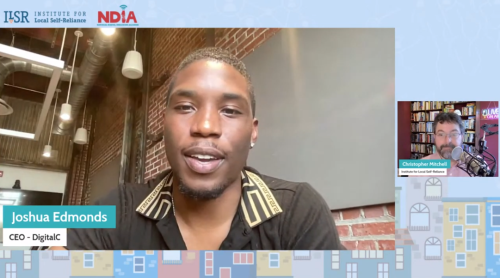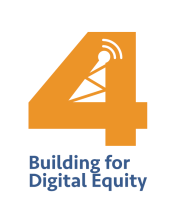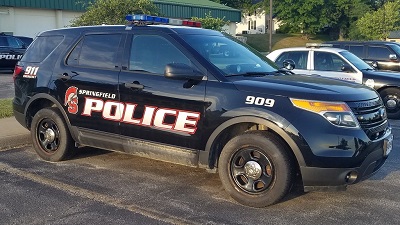
Fast, affordable Internet access for all.

In the wake of the new rules issued by the Federal Communications Commission (FCC) to prevent digital discrimination, digital equity advocates from California to Cleveland are leveraging the new federal rules to spur local action.
In Los Angeles, city leaders have passed an ordinance to combat what advocates say are discriminatory investment and business practices that leave historically marginalized communities without access to affordable high-quality Internet. Similar efforts to mobilize communities and local officials are underway in Oakland and Cleveland.
In November 2023, the FCC codified rules to prevent digital discrimination, outlining a complaint process whereby members of the public can offer evidence of digital discrimination being committed by Internet service providers (ISPs). Though the FCC order does not outline local policy solutions, nor does it empower localities to carry out enforcement of the federal rules, it has the potential to open up conversations between local advocates and elected officials about new ordinances, stronger enforcement of existing ones, or public investment to facilitate competition and the building of better broadband networks.
Los Angeles First City in Nation To Officially Define Digital Discrimination At Local Level
The local organizing work behind the proposed ordinance in LA dates back to 2022 when digital equity advocates began to document inequitable broadband access across the county.

Mapping is hard. You know it, and so do we. Despite that reality, at least from the outside, it looks like the FCC has spent the entirety of this decade avoiding the hard decisions necessary to make sure precious federal dollars are wisely used and the data that drives our policy is easily accessible and faithful to reality. This week on the podcast, Christopher is joined by Tom Reid, President and founder Reid Consulting Group. Tom shares what his firm has been doing to help local governments get around this persistent problem, and how with some thoughtful design and sophisticated data work we can use what is out there to build a pretty clear picture of the places we need to close the infrastructure gap.
Tom and Christopher end the show by talking a little about how the burden of proof in proving poor, unreliable, or no service is being extended to local governments, households, and nonprofits in the upcoming challenge process for states as the latter prepares for the next stage of the BEAD process.
This show is 37 minutes long and can be played on this page or via Apple Podcasts or the tool of your choice using this feed.
Transcript below.
We want your feedback and suggestions for the show-please e-mail us or leave a comment below.
Listen to other episodes here or view all episodes in our index. See other podcasts from the Institute for Local Self-Reliance here.
Thanks to Arne Huseby for the music. The song is Warm Duck Shuffle and is licensed under a Creative Commons Attribution (3.0) license.
Cleveland, Ohio is putting the finishing touches on an ambitious plan to build a citywide open access fiber network–and deliver affordable fixed wireless service–at minimal cost to city residents. The double-edged proposal aims to bring both meaningful broadband competition–and lower rates–to the long neglected city of 1.7 million people.
Last month, the city announced it had awarded $20 million in ARPA (American Rescue Plan Act) funds to Cleveland-based digital equity non-profit DigitalC. Under the proposal, DigitalC will spend 18 months building a fixed wireless broadband network capable of providing locals with symmetrical 100 Megabit per second (Mbps) service for $18 a month.
DigitalC’s fixed wireless service, EmpowerCLE+, launched in 2018 and accelerated its deployment in 2020 to meet the needs of frustrated parents and workers during peak COVID.
Speaking at ILSR’s and the National Digital Inclusion Alliance (NDIA) Building for Digital Equity (B4DE) event last week, DigitalC CEO Joshua Edmonds noted that the EmpowerCLE+ network currently passes 23,500 households in Cleveland, with 2,300 current subscribers. The city’s new agreement with the city should expand the network’s potential reach to 99.9% of homes in Cleveland.

“We're thankful for the opportunity and we're just really hoping that people use this as motivation to change things within their respective markets,” Edmonds told ILSR in a phone interview.
Lots happening for Digital Inclusion Week 2023, which kicks off this Monday. One free online event that will be of particular interest for digital equity advocates across the nation is the next National Digital Inclusion Alliance (NDIA) and Institute for Local Self Reliance (ILSR) Building for Digital Equity (#B4DE) Livestream.
The popular virtual gathering will be held this Tuesday, Oct. 3, from 12 noon to 1:15 pm ET and will focus on the DIW-inspired theme: “Building Connected Communities: Sustaining Momentum.”
Attendees can still register here.
Building on the success of our previous events, we are excited to present another engaging agenda packed with practical insights and information digital inclusion practitioners can use while working in the trenches to bridge America’s yawning digital divide.
The agenda includes:
The city of Dublin, Ohio has struck a public private partnership with altafiber (formerly known as Cincinnati Bell) to build a new citywide fiber network city leaders hope will finally deliver the kind of affordable, next-generation broadband access Dublin’s 50,000 residents have long been clamoring for.
In 2022 the city issued a request for proposal (RFP) looking for a partner on a citywide network build. At a June 26 meeting, the Dublin city council voted unanimously to select altafiber from a roster of seven potential applicants.
According to the arrangement, construction of the city network is expected to begin in Spring of 2024, with every premise in Dublin passed by a 10 gigabit per second (Gbps) capable network within three years. A select number of undetermined customers are expected to be brought online sometime in the latter part of next year, officials tell ILSR.
A city press release notes that altafiber will invest $35 million in the fiber network, as well as potentially providing the infrastructure necessary to help the city support either public Wi-Fi initiatives or a City Innovation Center. The city says it will pay about $6 million to bury the necessary fiber infrastructure citywide.

Bill Callahan, Executive Director of Connect Your Community, joins Christopher Mitchell to talk about some of the history of digital equity and the before-times that led to the formation of the National Digital Inclusion Alliance. We also discuss Cleveland and later NE Ohio more specifically after exploring how Internet access has changed in the area since their landmark report, "AT&T’s digital redlining of Cleveland."
This show is 19 minutes long and can be played on this page or using the podcast app of your choice with this feed.
Transcript below.
We want your feedback and suggestions for the show-please e-mail us or leave a comment below.
Listen to other episodes here or see other podcasts from the Institute for Local Self-Reliance here.
Thanks to Joseph McDade for the music. The song is On the Verge and is used per his Free-Use terms.

As she'll note in the beginning of this interview with Sean Gonsalves, Gina Birch loves her job as Program Coordinator at the Ashbury Senior Computer Community Center in Cleveland, Ohio. She discusses the remarkable transition in Cleveland from a city lagging in digital equity metrics to one toward the top of its game.
They discuss the Affordable Connectivity Plan, ACP, and some of the challenges associated with the digital divide. Finally, they discuss some of the lessons they have taken from the Net Inclusion conference.
This show is 14 minutes long and can be played on this page or using the podcast app of your choice with this feed.
Transcript below.
We want your feedback and suggestions for the show-please e-mail us or leave a comment below.
Listen to other episodes here or see other podcasts from the Institute for Local Self-Reliance here.
Thanks to Joseph McDade for the music. The song is On the Verge and is used per his Free-Use terms.
Summit County, Ohio says it’s making progress on a $75 million, 125-mile fiber-optic ring made possible courtesy of American Recovery Plan Act (ARPA) funds. The project will start by providing gigabit connectivity to all county first responders, after which county leaders say they’ll focus on shoring up lagging broadband access to long-neglected communities.
A 2017 report by an outside consultant found that Summit County, like so much of America, struggles with a dearth of affordable broadband access thanks to a heavily monopolized U.S. broadband market. The county’s fixed-line broadband market is dominated by two major incumbents, Centurylink and Comcast, and wireless access remains spotty across large swatches of the county’s more rural territories.
Introduced last year, Summit County Executive Ilene Shapiro noted the network will first connect all 31 city, village and township governments to gigabit speed broadband and a data center. The network is expected to cost as much as $75 million. $35 million of that total will be pulled from the $105 million in ARPA funding received by the county.

Summit County’s interest in more affordable broadband extends back years. County leaders played a key role in beating back monopoly efforts in the state legislature to effectively ban publicly-owned broadband networks. Once those efforts were defeated, county leaders began formulating their broadband expansion plans in earnest.
Despite the release of the first draft of the new national broadband maps at the end of last year (and the first round of location-level and service availability corrections completed a couple of weeks ago), we're not holding our breath that 2023 will spell the end of the technology news cycle story trope of the family that buys a new house and learns that the monopoly ISPs don't actually know where they provide service in their territories across the United States.
How, more than three decades after we began rolling out national information infrastructure, does such a basic failure persist? Sometimes, it happens because network infrastructure has changed hands so many times (and with so many layoffs), that documentation has become tangled and gap-ridden. In many instances, however, it's purposeful: ISPs have for years claimed they just don't know where they offer service to, and that it would be too expensive to find out: all as part of a larger strategic plan to prevent competition. Meanwhile, the nation's premier telecommunications expert regulatory agency - the FCC - has bought this line with little pushback.
The problem is that when it happens, it's rarely the provider that gets punished. Instead, it's homeowners who assumed that moving to a suburb meant there would be Internet access nearby, only to discover that bad DSL or worse geostationary satellite service are the only options. Perhaps most frustratingly is when the provider itself - like Comcast did to a family closing on a new house in Buckley, Washington in 2021 - tells a family it services an address and completes a work order, only to cancel the install a couple of days before closing and demand $19,000 from the family for the pleasure of becoming a subscriber. Comcast seems to be a particularly bad offender, though of course Charter Spectrum, RCN, and others habiltually do it too.
This is exactly what happened to Geoff Wiggins when his family moved to Ohio. On the most recent episode of the Connect This! Show, Geoff joins to share what happened when he moved to a house and discovered that it was in the Bermuda Triangle of broadband service, and what he's done to try and fix it.
In an economy where inflation seems to be everywhere, Fairlawn, Ohio residents are getting a bit of welcome news.
Subscribers to FairlawnGig – Fairlawn, Ohio’s municipal broadband network – are being upgraded to new service levels as the city-owned network bumps up speeds and slashes prices to make its fiber Internet service faster, and even more affordable.
Earlier this week, FairlawnGig announced that subscribers who had been getting Fairlawn’s basic service tier of symmetrical 300 Megabits per second (Mbps) were being upgraded to symmetrical gig speed service – for the exact same price of $55/month.
FairlawnGig also announced that subscribers who had previously been getting gig speed service will see their bills drop down to $55/month instead of the $75/month they had been paying. Meanwhile, subscribers who were getting 2.5 Gigabits per second (Gbps) for $150/month will now be upgraded to a symmetrical 5 Gbps tier, and see their price drop to $100/month.
“That was always the plan from the very beginning,” the City of Fairlawn’s Public Service Director Ernie Staten told ILSR this week.
We have been striving at all times to bring the greatest speeds and to bring prices down. We have made it where we have done well enough financially to start lowering prices and providing greater speeds.
Local Businesses Threatened to Leave – Unless Better Internet Comes to Town
Fairlawn, a small city of approximately 7,500 Ohioans about 10 miles northeast of Akron, created a telecommunications utility in 2015 to bring city-wide access to high-speed Internet service after years of dealing with subpar broadband offerings from the incumbent providers.